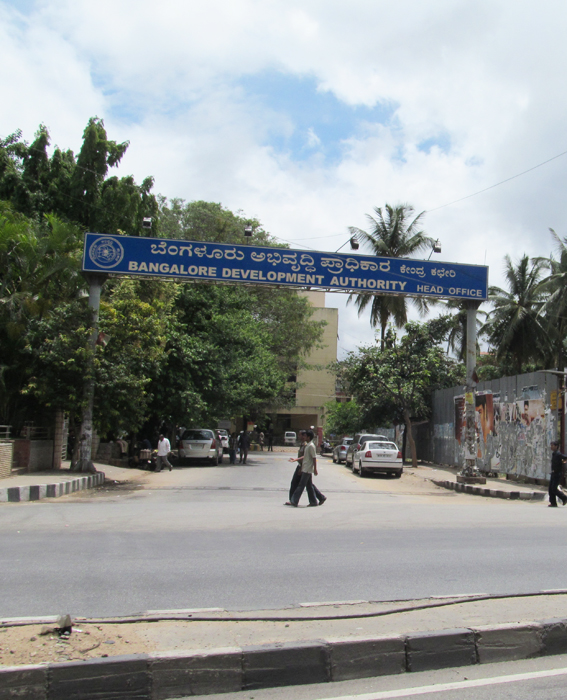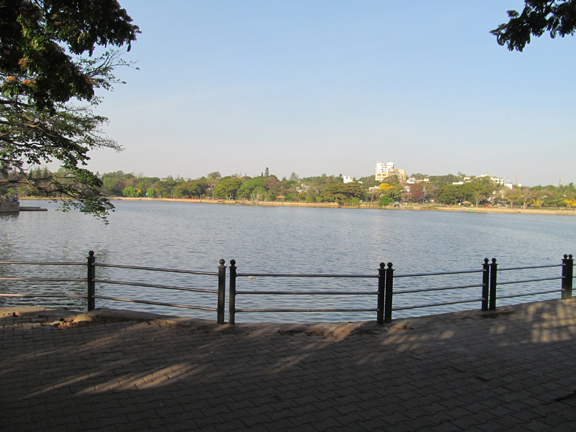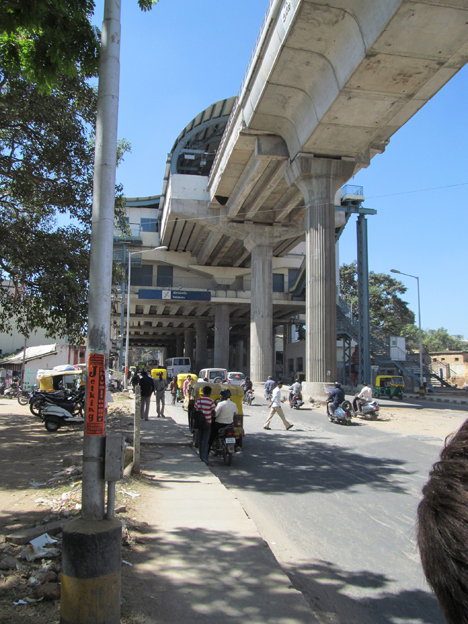The idea of planning and a planned society is accepted now in varying degrees by almost everyone. But planning by itself has little meaning and need not necessarily lead to good results… Does the plan aim definitely at the well-being and advancement of the people as a whole, as the opening out of opportunity to all and the growth of freedom and methods of co-operative organization and action? —Jawaharlal Nehru, 1944
In March D-A-P ran an interview and an article dealing with the commons in India. Bangalore has had an urban planning process in place for fifty years and its latest update (2015) is due any time. The following interview with Indian architect and professional planning consultant Brinda Sastry is a follow-up to those discussions.

The BDA, located on Chowdaiah Road, Bangalore
DAP: Having a GIS map of its environs must be an advantage for Bangalore. Have other Indian cities followed suit?
Brinda Sastry: Many Indian cities have GIS maps including cities such as Mysore and New Delhi, and smaller towns such as canadian drug pharmacy Hubli in Karnataka. In the case of Bangalore, the GIS enabled base map was used to make planning recommendations for the Master Plan 2015. That an extensive geo data repository was prepared after gathering data from several stakeholders is significant, and spatial and non-spatial data were analyzed to feed into the decision-making. For the first time the city’s environmentally sensitive areas such as the valleys and tanks were mapped using GIS to ensure their protection.
DAP: I understand that water preservation is important to a city at Bangalore’s elevation. The catchment reservoir area west of town, and the traditional tanks are being supplemented by an incentivized rain water harvesting scheme to secure the city’s water supply. During a recent downpour I observed rainwater runoff cascading down a city street at a near flash-flood rate. What more needs to be done to improve Bangalore’s water management?
Brinda Sastry: In the last few months, BBMP has been constructing water harvesting sumps in public areas such as below the Namma Metro elevated corridors and along some major streets (recently seen in Basavangudi). The BBMP has budgets for de-silting the storm water drains and cleaning up the inlets to these drains. It has made water harvesting compulsory for private plots over 2400 sq feet. Chennai has alleviated its water shortage problem by enforcing rain water harvesting throughout the city. I’m not a water management expert, but I think such efforts along with localized water harvesting measures, reduction of impervious surfaces and enforcement of building norms in flood prone areas will help.

Sankey’s Tank, one of Bangalore’s legacy reservoirs
DAP: When we met you spoke about working on a plan for High-Tech City that wasn’t implemented. What are some of the pitfalls for implementation of urban plans in India?
Brinda Sastry: The Plan I was involved in was the IT Corridor Plan. The Hi-Tech City was proposed subsequently in the Master Plan by the BDA. The major hurdle for implementing these plans is land acquisition. Also such exclusive areas raise issues of governance.
DAP: To an outsider Bangalore seems like a City of Flyovers, but I’m told they are common in other Indian cities. Construction of such systems must be exorbitantly expensive. Is it the common perception that an elevated layer like the METRO will ease street-level congestion, or are such projects being undertaken at the expense of what already exists below?
Brinda Sastry: Yes, flyovers are present in all metropolitan cities. I really don’t know what the common perception regarding the Namma Metro is. Several newspapers (Times of India, Deccan Herald, The Hindu) have interviewed people on their opinion of the Namma Metro and they seem to be varied. Many have opined that the rail line should have been underground or at grade. There is some hope that Namma Metro will ease the city’s traffic congestion. It will be effective if facilities are provided to link pedestrians and other modes of transport (cars, autos, cabs, bicycles and buses) to the Metro stations; if the stations are better designed to generate pedestrian-friendly public places that are connected with the adjoining neighbourhood; and if the last kilometer connectivity issues are addressed. In addition, implementation of development controls that focus on mixed use and compact development around the stations are critical. This calls for a cross-jurisdictional cooperation among the various agencies that are involved in the Metro project and the city’s development. They need to work towards a common goal that makes the system work for the common person. It also calls for neighbourhood level planning and implementation of innovative development mechanisms that promote affordable, inclusive and livable places around the Metro stations.

Bangalore’s state-of-the-art but lightly traveled Metro
DAP: I went to the Bangalore Development Authority website and was amazed to learn that the Commissioner of Police and the Bangalore Tax Revenue Office are subsumed under its authority. Also surprised to see that it is assumed that 10% of the city is composed of 500 small slums. Does the Bangalore Development Authority regulate and license urban street vendors also?
Brinda Sastry: The Commissioner of Police is the Chief of Bangalore City Police and Police Services comes under the Home Department. As far as I know, the BDA has only a Police Superintendent within its organization. Also, the BDA collects taxes for property within its jurisdiction, but the Revenue Department is not included within the BDA. The BBMP provides licenses to street vendors, not the BDA.
DAP: A solution to urban sprawl in American cities is to propose densification of the urban core, but many parts of Bangalore already feel crowded and overbuilt. Following the Club of Rome’s 1972 report, has there ever been a perception here that maybe Bangalore should consider The Limits to Growth?
Brinda Sastry: Bangalore may “feel” crowded because of the traffic and congested streets. There is a lot of potential to build in the core area. Regarding the Club of Rome’s “The Limits to Growth,” – I’d say that some principles of the Bangalore Master plan do address the impacts of uncontrolled growth. The Plan proposes densification of the older core along with widening of streets (which in some cases are not practical) and densification along the Namma Metro lines and around the stations. A major constraint that influenced the planning of the city was water shortage. Directions of growth were considered with this in mind. Particularly in the Bangalore Metropolitan Region’s Structure Plan (RSP 2031), that is currently under consideration for approval by the Government, water availability is a major factor driving the growth concept. As in the case of most metropolitan cities, Bangalore too faces the dilemma of spending more on upgrading infrastructure in the city core to support increased development versus cost of providing infrastructure in the outlying areas of the city. A significant principle adopted in the Master Plan (2015) that considers sustainable growth options looks at maintaining a balance between the natural and built environment. To this end, the valleys (natural drainage systems), tanks and other ecologically sensitive areas have been mapped and zoned as non-buildable areas and buffers are provided around them for protection. The Regional Plan also identifies, through GIS analysis, the land capabilities and proposes policies that promote most productive uses for land with the intent of protecting ecological systems. While these policies are in place, implementation and enforcement of the same by the Government is critical to their success.
DAP: I’ve written about how Bangalore city ordinance requires rickshaw operators to purchase smog-reducing lpg or cng models but, depending on the weather, the air quality is still often very bad. Can anything more be done to reduce both vehicular air and noise pollution in Bangalore? Brinda Sastry: Encourage people to ride public transit. Regulate vehicular parking. The “Bus Day” on the fourth day of every month is a good initiative, but we need something more aggressive. Private firms should provide employees with incentives to use public transit. Maybe, the most recent hike in petrol prices will force people to do so.

DAP: Lots of municipal and quasi-corporate entities are named as stakeholders in the Bangalore Master Plan, such as Karnataka Power Transmission Corporation Limited and Bangalore Metropolitan Transport Corporation, but no citizen groups. Apparently, the Karnataka Town and Country Planning Act (1961) does not allow for direct citizen participation, although Janaagraha facilitated citizen responses to the Master Plan presentation. The BDA seems a little self-conscious about this loophole. Do you see it being corrected anytime soon?
Brinda Sastry: The KTPC Act allows for soliciting comments and suggestions at the end of the Plan process for a 60 day period. The 74th Constitution Amendment calls for decentralization of planning powers to local bodies. In an unprecedented move, the BDA recently posted a public notice on its website soliciting comments from the general public on the Master Plan 2015 which is due for revision. Subsequently the BDA posted the Request for Proposals (RFP) for the preparation of Revised Master Plan -2035, which requires a participatory process among other planning tasks. One hopes that the process will encourage direct involvement. While these seem to be conscious steps in the right direction, it remains to be seen as to how they will work eventually.
Brinda Sastry holds a Diploma in Architecture from the School of Architecture, CEPT, Ahmedabad and a Masters Degree in Architecture (Urban Design) from the University of Oregon, USA. Over the last 20 years, she has worked on several regional, city and neighbourhood plans, both in India and the USA. Her specific contributions are towards preparing visions, policies, development regulations, urban design guidelines and participatory processes. Contact: brinsastry@gmail.com











Leave a Reply
You must be logged in to post a comment.